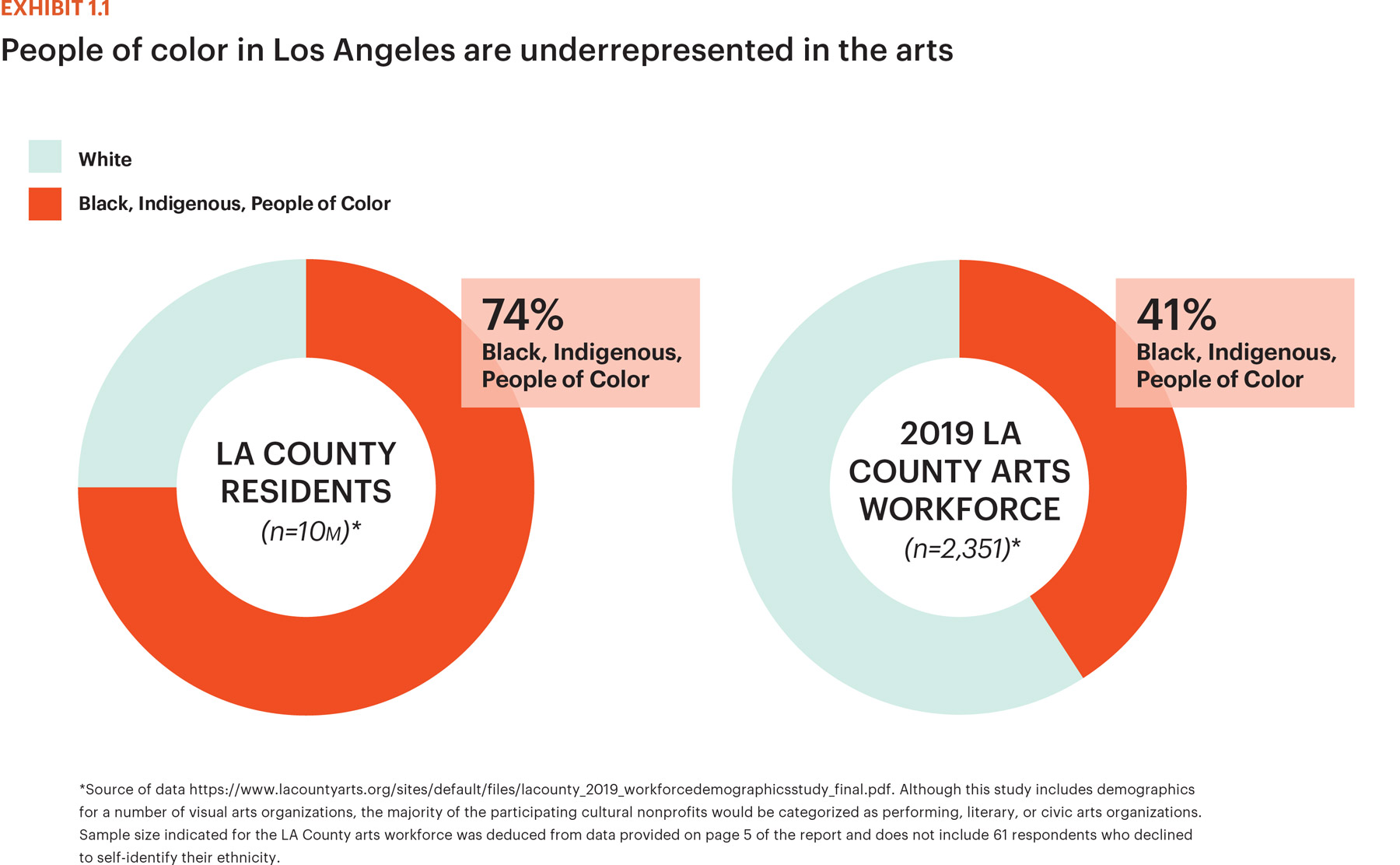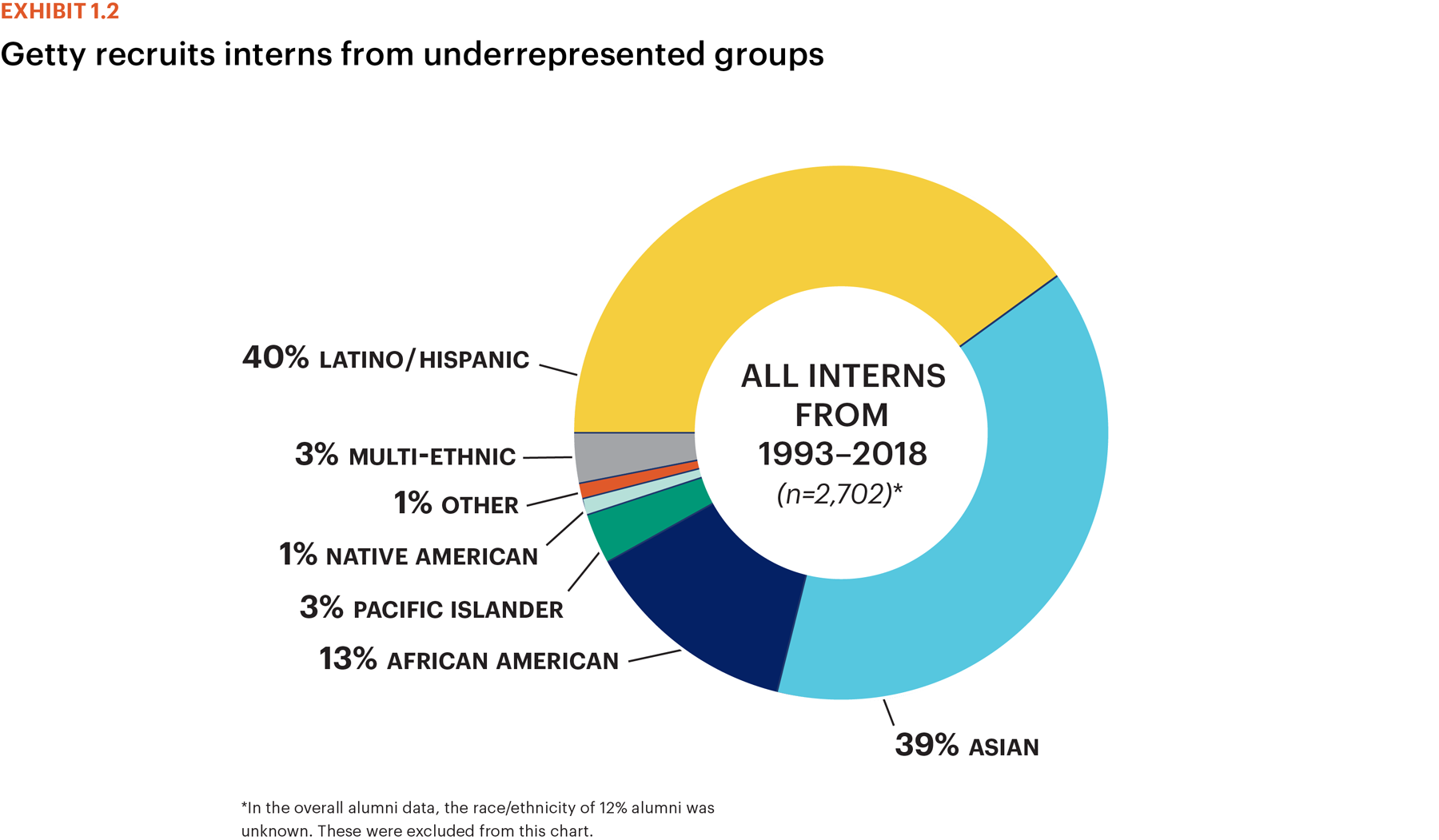The Model
Getty Marrow internships are designed to provide meaningful work experience in the arts for undergraduate students from groups underrepresented in museums and visual arts organizations who either live or attend school in Los Angeles County. The program employs a unique model that includes recruiting applicants from diverse backgrounds, funding thoughtful and wide-ranging positions at a variety of arts organizations, mentoring from dedicated supervisors, paying a living wage, and building professional communities through networking activities. The program components are presented here, along with supporting data points.
Diversity: Getty Marrow interns come from underrepresented cultural groups
People of color in Los Angeles County are underrepresented in the arts. Exhibit 1.1 shows how the demographics of Los Angeles County as a whole compare to its arts and culture workforce. The workforce data for Los Angeles County are taken from a survey of staff members, board members, volunteers, and independent contractors across the entire arts sector, not only the visual arts. Getty’s program is locally based, but nationwide data taken from a recent Andrew W. Mellon Foundation report1 surveying the staff of art museums that are members of the American Alliance of Museums (AAM) or the Association of Art Museum Directors (AAMD) showed an even lower proportion of people of color at a national level.
The Getty Marrow internship program recruits undergraduate students who are from or attend college in Los Angeles County and who are members of traditionally underrepresented groups in arts professions. Exhibit 1.2 shows the demographics of all Getty Marrow alumni.
In order to attract applicants from a heterogeneous array of undergraduate institutions, the Getty Foundation undertakes broad outreach efforts at public and private universities, four-year institutions, and community colleges. For example, 51% of alumni (n=1,549) pursued their undergraduate education at public universities; of those, 52% attended University of California schools, 31% attended California State Universities, 15% attended community colleges, and 2% attended public universities in other states.
Scale: Getty funds an array of internship types at many different organizations
Prospective interns can apply for positions representing a broad array of career tracks at dozens of arts organizations, large and small, from major museums such as LACMA and the Hammer Museum to culturally specific institutions such as the California African American Museum and community-based arts organizations such as Self Help Graphics & Art.
A vast majority of alumni surveyed (over 85%)2 agree or strongly agree that they were exposed to a variety of professional opportunities. As one alum explained, “There aren’t comparable programs that I know of on that same scale…. [The program] introduces students to this wide range of cultural organizations instead of just feeding one museum.” This is important because alumni can experience the full variety of careers that exist within the arts; positions are not just limited to curatorial work but extend to all areas of museum practice.
Of the organizations participating in the program as of 2019, 90% have seen their interns pursue careers in the arts. Of the 10% who have not produced alumni in the field, many are new to the program. For a full list of present and past participating organizations, please see “Host Organizations”.
Substance: Internships provide meaningful work experiences
The Foundation requires that participating organizations offer their interns substantive projects. Nearly all (94%) of alumni3 agree or strongly agree that their work during the internship was meaningful. Alumni provided numerous accounts of the extent to which the internship exposed them to the arts and gave them opportunities to build their skills and experience. As one alumni said, “I was never given an assignment just as busy work. Everything that I did was valuable.”
Compensation: Paid internships ensure equity and make people feel valued
The Foundation has insisted from the start that all interns receive compensation. This decision was made not only to attract talent, but also to ensure greater equity in who is able to participate. The stipend has grown over time and is currently set at $6,000 ($15 per hour) in accordance with the Los Angeles County Minimum Wage Ordinance. Grants made by the Getty Foundation to host organizations cover the intern stipends and provide $500 per intern to support overhead costs.
“So many of my peers from college have a very different perspective on museums and the art world because they were not paid for their labor from the very beginning. That initial open door is so crucial to how one views the feasibility of a career in the arts.” Getty Marrow Alum
Many alumni explained that, without pay, they would not have been able to participate because a summer without income was not an option. Others spoke about the symbolic significance of being paid and how the stipend validated their contributions.
Mentoring: Supervisors provide essential guidance and support
Alumni consistently reported that supervisors played a key role in their internships with 88% agreeing or strongly agreeing that supervisors provided them the guidance and support they needed. Many alumni recounted deep and authentic relationships with supervisors. “My supervisor took the time at the end of every day for us to check in and reflect on everything that I did,” recalled one alum who appreciated a supervisor’s efforts to connect daily tasks to big picture ideas. Other alumni stressed the value of supervisors helping interns connect with other staff and the importance of physical proximity to others whenever possible. The Foundation emphasizes these points among others as part of an annual supervisor orientation that occurs each year before the interns start their work. Many supervisors extend this dedication after the internship ends and regularly support interns in ways both big and small, from writing letters of recommendation and serving as employment references to attending events organized by former interns who now work in the arts.
Networking: Interns build and sustain professional communities
Many alumni noted the importance of networks to building a career in the arts, not only those with supervisors and mentors but also with peers interning at other organizations. Getty has considered these factors carefully in the internship program’s overall design.
“One thing that’s really special about the Getty internship is that it’s always tied to a bigger network and the field in general.” Getty Marrow Alum
While interns spend most of their time with the staff of their host institution, the Foundation has always offered additional programming that brings interns together, both in smaller peer groups and at annual professional development days attended by the full cohort of 100+ individuals. Interns attributed great benefit to these program elements.
Notes
Mariët Westermann, Roger C. Schonfeld, and Liam Sweeney, “Art Museum Staff Demographic Survey 2018,” The Andrew W. Mellon Foundation, January 28, 2019, https://mellon.org/media/filer_public/e5/a3/e5a373f3-697e-41e3-8f17-051587468755/sr-mellon-report-art-museum-staff-demographic-survey-01282019.pdf ↩︎
Alumni were not asked this question in 2012; over 85% in 2008 and 88% in 2019 agreed or strongly agreed that they were exposed to a variety of new professional opportunities through the internship. ↩︎
Alumni were not asked this question in 2012; 94% in 2008 and 2019 agree or strongly agree that their work during the internship was meaningful. ↩︎

